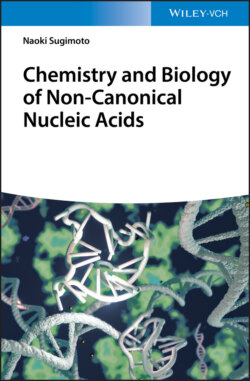Читать книгу Chemistry and Biology of Non-canonical Nucleic Acids - Naoki Sugimoto - Страница 15
1.5 Perspective of the Research for Non-canonical Nucleic Acid Structures
ОглавлениеAs the regulation of gene expression by the specific structure of nucleic acids has been clarified, the next important issue is knowing what specific structures are formed where and when in cells. For example, Hoogsteen base pairs are affected by the molecular environments such as ions, pH, and water activity. Cells are in an environment crowded with molecules, so-called molecular crowding (see Chapters 3 and 4), and the molecular environment changes depending on the cell cycle [14]. For example, the nucleolus causes a change in the molecular density in the nucleus by repeating formation and dissociation according to the cell cycle. This regulates the timing of activation of rRNA transcription in each cell cycle, because the transcription of rRNA specifically occurs in nucleolus. In addition, the environment of mitochondria is particularly crowded (up to 500 mg ml−1) but heterogeneous due to locally increased proton concentration by the proton gradient required for ATP synthesis. Therefore, it is desirable to develop a technology that can predict physicochemical property of specific structures due to Hoogsteen base pairs in each characteristic molecular environment [15]. In addition, there is a possibility to make a new approach of drug development that treats diseases by changing the molecular environments of cells, rather than targeting genes and proteins.
